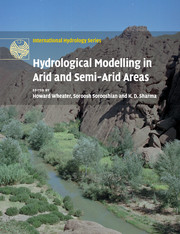Book contents
- Frontmatter
- Contents
- List of contributors
- Preface
- Acknowledgements
- 1 Modelling hydrological processes in arid and semi-arid areas: an introduction
- 2 Global precipitation estimation from satellite imagery using artificial neural networks
- 3 Modelling semi-arid and arid hydrology and water resources: The southern Africa experience
- 4 Use of the IHACRES rainfall-runoff model in arid and semi-arid regions
- 5 KINEROS2 and the AGWA modelling Framework
- 6 Ephemeral flow and sediment delivery modelling in the Indian arid zone
- 7 The modular modelling system (MMS): a toolbox for water and environmental resources management
- 8 Calibration, uncertainty, and regional analysis of conceptual rainfall-runoff models
- 9 Real-time flow forecasting
- 10 Real-time flood forecasting: Indian experience
- 11 Groundwater modelling in hard-rock terrain in semi-arid areas: experience from India
- Appendix Access to software and data products
- Index
- Plate section
Appendix Access to software and data products
Published online by Cambridge University Press: 15 December 2009
- Frontmatter
- Contents
- List of contributors
- Preface
- Acknowledgements
- 1 Modelling hydrological processes in arid and semi-arid areas: an introduction
- 2 Global precipitation estimation from satellite imagery using artificial neural networks
- 3 Modelling semi-arid and arid hydrology and water resources: The southern Africa experience
- 4 Use of the IHACRES rainfall-runoff model in arid and semi-arid regions
- 5 KINEROS2 and the AGWA modelling Framework
- 6 Ephemeral flow and sediment delivery modelling in the Indian arid zone
- 7 The modular modelling system (MMS): a toolbox for water and environmental resources management
- 8 Calibration, uncertainty, and regional analysis of conceptual rainfall-runoff models
- 9 Real-time flow forecasting
- 10 Real-time flood forecasting: Indian experience
- 11 Groundwater modelling in hard-rock terrain in semi-arid areas: experience from India
- Appendix Access to software and data products
- Index
- Plate section
Summary
The data products and models referred to in the book are available as described below. Additional workshop material, including lecture/tutorial presentations, are available from the G-WADI web-site www.g-wadi.org.
DATA PRODUCTS
The satellite-based precipitation measurement algorithm, PERSIANN (Precipitation Estimation from Remotely Sensed Information using Artificial Neural Networks), continuously provides near global rainfall estimates at hourly 0.25°×0.25° scale from geostationary satellite longwave infrared imagery. An adaptive training feature enables model parameters to be constantly adjusted whenever independent sources of precipitation observations from low-orbital satellite sensors are available. The current PERSIANN algorithm has been used to generate multiple years of research quality precipitation data. PERSIANN data is available through HyDIS (Hydrologic and Data Information System: http://hydis8.eng.uci.edu/persiann/) at CHRS (Center for Hydrometeorology and Remote Sensing), University of California at Irvine. See Chapter 2 for further details.
MODELLING TOOLS
The Institute for Water Research, Rhodes University, South Africa, has developed the SPATSIM (Spatial and Time Series Information Modelling) system for Windows. This package makes use of an ESRI Map Objects spatial front end, linked to a database table structure, for data storage and access and includes relatively seamless links to a range of hydrological and water-resource estimation models. It also includes a wide range of data preparation and analysis facilities typically required in hydrological modelling studies. The SPATSIM approach has been adopted as the core modelling environment to be used for the update of the South African water-resource information system.
- Type
- Chapter
- Information
- Hydrological Modelling in Arid and Semi-Arid Areas , pp. 191 - 192Publisher: Cambridge University PressPrint publication year: 2007

